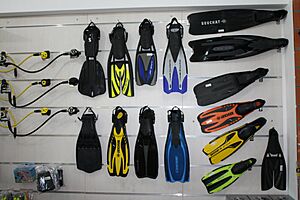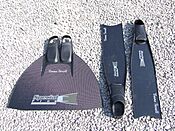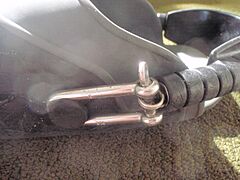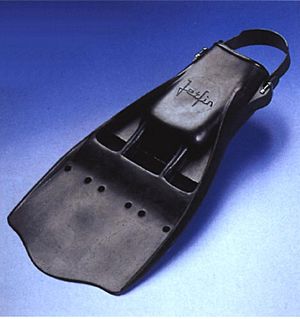Swimfin facts for kids
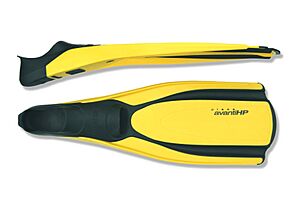
Full foot fins
|
|
| Other names | Fins, flippers |
|---|---|
| Uses | Diver and swimmer propulsion |
Swimfins, swim fins, diving fins, or flippers are finlike accessories worn on the feet, legs, or hands and made from rubber, plastic, carbon fiber, or combinations of these materials. They help the person wearing them to swim faster because the swimfins push more water per kick than smaller surfaces like the swimmer's feet.
People who take part in water sports wear swimfins. Some of these activities are swimming, bodyboarding, bodysurfing, float-tube fishing, kneeboarding, riverboarding, scuba diving, snorkeling, spearfishing, underwater hockey, and underwater rugby.
History
Early inventors, including including Leonardo da Vinci and Giovanni Alfonso Borelli, thought that making something like duck's feet would help a person swim faster. Benjamin Franklin made a pair of swimfins for his hands when he was a young boy living in Boston, Massachusetts.
Louis de Corlieu, capitaine de corvette (Lieutenant Commander) in the French Navy, invented modern swimfins. He showed them to the Navy in 1914. In 1926, he left the Navy to fully devote himself to his invention. He was finally able to mass produce his swimfins in France in 1939.
The same year he issued a license to Owen Churchill for mass production in the United States. Churchill showed his fins to the US Navy, and "Churchill fins" were used during World War II. In Britain, Dunlop made frogman's fins for World War II.
Types
Different types of fins exist for different users:
- Snorkelers use lightweight flexible fins.
- Free divers prefer extremely long fins to help them save their energy.
- Scuba divers need large wide fins because their diving equipment causes water resistance.
- Underwater hockey and underwater rugby players use either full-foot or open-heel fins. They need both power when swimming in a straight line and the ability to turn quickly.
Most fins come as a pair with one fin worn on each foot. These are also called bifins. A monofin is one wide fin blade attached to two foot pockets. They look similar to how most people picture mermaid tails.
Some swimfins are worn like a slip-on shoe and cover the whole foot. They can be called full-foot, closed-heel, or slipper fins. Others have an open heel with a foot pocket in the front and an adjustable strap worn behind the heel.
The paddles of swimfins can be shaped differently depending on how they will be used. Some paddles have special holes called vents that let water through on the recovery stroke (the "up kick") and do not let water through on the power stroke (the "down kick"). This helps swimmers save energy for the power strokes.
When swimfins are too loose on the foot, people can wear a fin grip, or fin retainer. These Y-shaped rubber straps are worn over the arch, the heel, and the instep of each foot to keep the swimfin secure on the foot.
Use
Swimmers can use different kinds of kicks when they are wearing swimfins.
- The scissor or flutter kick uses both legs to move up and down at the hips. The legs move opposite each other. When the right leg is up, the left leg is down. When the left leg is up, the right leg is down.
- The frog kick is named this way because the motion looks like frogs' legs when they swim. Both legs come up the center and slowly rotate out so the knees face outward and the heels are close to the bottom. The legs slowly extend outward and then come together quickly and forcefully so that the swimmer's body is straight and can glide through the water.
- The dolphin kick uses both legs together. It is the only kick available when a swimmer is using a monofin. The swimmer moves his legs up and down at the same time.
- Other kicks like the back kick and the helicopter turn can be used to move and turn in different directions.
Interesting facts about swimfins
- Louis de Corlieu invented the first rubber fins. They had a metal core to keep them rigid.
- Aquatic festivals and competitions took place in Paris, where they used the "de Corlieu" swimfins.
- The first recorded performance using fins is 59 seconds for 216 feet (66 meters).
- During aquatic “ballets,” a monofin made a first appearance. It was made of two “de Corlieu” fins glued together in the middle.
- Luigi Ferraro set out to design a new style of swimfins in 1950. His fins covered the whole foot but left the toes free.
- Ferraro started organizing competitions where the swimmers were equipped with fins.
- Fins can be made from rubber, plastic, and carbon fiber.
- When Benjamin Franklin was 11, he invented swimfins for the hands. He said that they helped him swim faster but made his wrists tired.
See also



